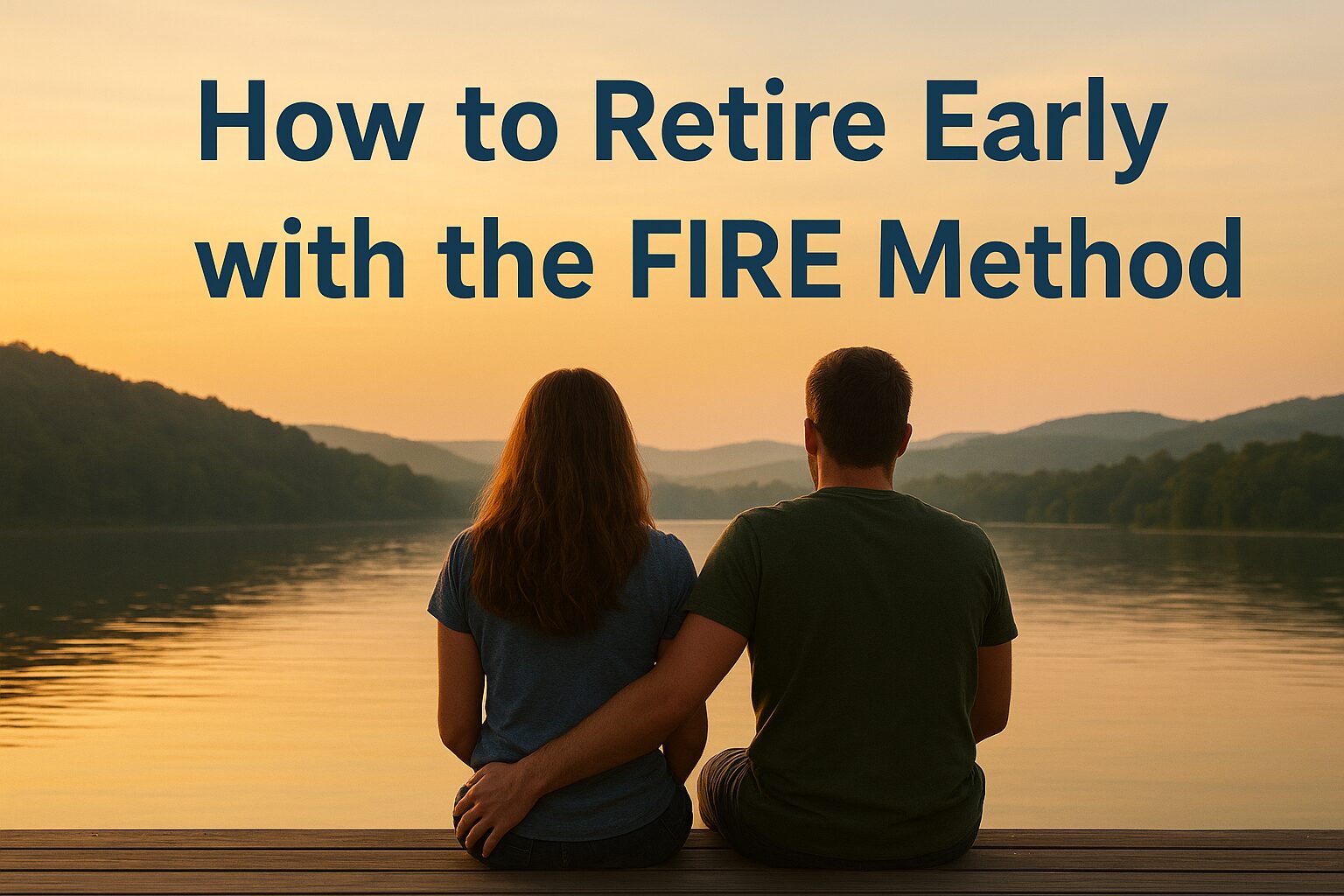Have you ever dreamed of walking away from your job decades early and living life on your own terms? The FIRE Method makes early retirement and financial independence possible.
.In today’s fast-paced world, more people are realizing that time is more valuable than money. The FIRE Method — which stands for Financial Independence, Retire Early — has become a movement among those who want to escape the 9-to-5 grind sooner rather than later.
Understanding the FIRE Method
The FIRE Method is a lifestyle and financial strategy that focuses on saving and investing aggressively to reach financial independence as early as possible.
What FIRE Stands For
- Financial
- Independence
- Retire
- Early
The core principle is simple: spend less, save more, and invest wisely. Instead of working for 40+ years and retiring at 65, FIRE followers aim to build enough wealth to retire decades earlier — often in their 30s or 40s.
The movement began in the 1990s after the release of the book Your Money or Your Life by Vicki Robin and Joe Dominguez. It gained massive popularity through online communities, Reddit threads, and blogs like “Mr. Money Mustache.”
Common Misconceptions
- You don’t need to earn six figures to achieve FIRE.
- It doesn’t mean never working again — some choose part-time or passion projects.
- FIRE isn’t about being cheap; it’s about being intentional with your money.
Visual Suggestion:
Infographic idea — “How the FIRE Method Works”
Flow: Earn → Save Aggressively → Invest → Reach Financial Independence → Retire Early
The Key Components of the FIRE Method
1. Aggressive Saving
FIRE followers typically save 50% to 70% of their income. This might sound impossible, but it becomes manageable once you:
- Track every expense
- Eliminate unnecessary spending
- Prioritize high-impact savings goals
Example Budget Breakdown:
| Category | Percentage of Income |
|---|---|
| Essentials (rent, food, bills) | 40% |
| Investments/Savings | 50% |
| Fun or Travel | 10% |
Tip: Automate your savings each payday. Treat savings like a non-negotiable bill.
2. Smart Investing
Saving alone won’t make you wealthy — investing is what accelerates your path to FIRE.
Common FIRE Investment Options:
- Index Funds: Low-cost and diversified (like S&P 500 funds)
- ETFs: Flexible, accessible, and tax-efficient
- Dividend Stocks: Provide steady passive income
- REITs (Real Estate Investment Trusts): For real estate exposure without owning property
Compound Growth Example:
If you invest $1,000 monthly at a 7% annual return, in 20 years you’ll have around $520,000 — more than double what you contributed.
3. Frugality Mindset
FIRE isn’t about deprivation. It’s about intentional spending — focusing on what brings value.
- Avoid lifestyle inflation (increasing expenses as income grows)
- Embrace minimalism
- Choose experiences over things
“Frugality gives you freedom, not restriction.”
4. Your Financial Independence Number
To know when you can retire, calculate your FI Number — the amount you need to live comfortably without working.
Formula:
FI Number = Annual Expenses × 25
Example:
If you spend $40,000 yearly → $40,000 × 25 = $1,000,000.
That means you need $1 million invested to safely withdraw 4% annually and live indefinitely off your investments.
Types of FIRE: Choosing What Fits You
There’s no one-size-fits-all FIRE plan. Here are the main types:
| Type | Description | Lifestyle Example |
|---|---|---|
| Lean FIRE | Minimalist lifestyle with tight budgeting | Living simply on <$30K/year |
| Fat FIRE | Comfortable lifestyle with luxuries | Living on $100K+/year |
| Barista FIRE | Semi-retirement with part-time work | Working part-time for health benefits |
| Coast FIRE | Investments grow on their own | Stop saving early, let compounding work |
Graph Suggestion:
Comparison chart of FIRE types — Savings needed vs. Lifestyle cost
Step-by-Step Guide to Achieving FIRE
Step 1: Assess Your Finances
- Calculate your net worth (assets – debts)
- Track your expenses for at least three months
- Use apps like Mint, YNAB, or PocketGuard
Step 2: Set Clear Goals
Define what financial independence means to you.
Do you want full FIRE or just more freedom to choose part-time work?
Step 3: Cut Unnecessary Expenses
Eliminate spending leaks such as:
- Subscription services you don’t use
- Eating out daily
- Impulse online shopping
Use the 48-hour rule — wait two days before making a non-essential purchase.
Step 4: Increase Income Streams
Boost your savings rate by earning more.
Try:
- Freelancing or side hustles
- Investing in dividend-paying stocks
- Creating digital products or online courses
Step 5: Invest for Growth
Put your money in low-cost index funds or ETFs.
Diversify across asset types and review your portfolio yearly.
Step 6: Monitor & Adjust Regularly
Every 6–12 months:
- Recalculate your FI number
- Check investment performance
- Adjust savings if needed
According to Fidelity, investors who consistently save 15% of income from age 25 can retire comfortably by 65. With FIRE, people aim to double or triple that rate.
Real-Life Examples and Case Studies
- Mr. Money Mustache: Retired at 30 by saving 66% of his income and investing in index funds.
- The Mad Fientist: Achieved financial independence through high savings and tax-efficient investing.
- Alyssa (Software Engineer): Cut expenses, started side hustles, and reached Coast FIRE by 35.
Key Lessons:
- High savings rate matters more than a high income.
- Simplicity and consistency beat risky investments.
- FIRE doesn’t require perfection — just persistence.
Common Challenges and How to Overcome Them
| Challenge | Solution |
|---|---|
| Inflation | Invest in inflation-protected assets (like TIPS or real estate) |
| Market Volatility | Stay diversified and avoid panic selling |
| Unexpected Expenses | Keep an emergency fund worth 6–12 months of expenses |
| Losing Motivation | Join FIRE communities or track your progress visually |
Remember, FIRE is a long-term lifestyle, not a short sprint. Progress may feel slow at first, but compounding always rewards patience.
Tools and Resources for FIRE Enthusiasts
Top Budgeting Apps:
- YNAB (You Need A Budget) – Ideal for detailed expense tracking
- Mint – Free, beginner-friendly
- Empower (formerly Personal Capital) – Great for net worth tracking
Investment Calculators:
- FIRECalc
- NerdWallet’s Retirement Calculator
Books & Podcasts:
- Your Money or Your Life by Vicki Robin
- The Simple Path to Wealth by JL Collins
- ChooseFI Podcast
Benefits of Reaching FIRE
- Time Freedom: Spend your days however you want
- Stress Reduction: No more worrying about monthly bills
- Personal Growth: Pursue hobbies, travel, or passion projects
- Family Time: Be more present with loved ones
Ultimately, FIRE gives you the ability to design a life you truly enjoy — not one controlled by your job
Is FIRE Right for You?
The FIRE Method isn’t for everyone. It requires discipline, patience, and long-term vision.
Ask Yourself:
- Am I willing to live below my means?
- Can I stay consistent for 10–15 years?
- Does financial freedom matter more than luxury now?
If you answered yes, you might be ready to start your FIRE journey.
Alternatives to Full FIRE:
- Mini-Retirements: Take 6–12 month breaks every few years.
- Sabbaticals: Rest and recharge without quitting permanently.
- Part-Time Work: Maintain flexibility and stability.
Conclusion
Reaching financial independence and retiring early isn’t just a dream — it’s achievable with the right mindset and habits. The FIRE Method encourages you to take control of your money, invest smartly, and live intentionally.
Even if you don’t aim to retire by 40, adopting FIRE principles can help you:
- Build long-term wealth
- Reduce financial stress
- Gain the freedom to choose how you live
FAQs About the FIRE Method
1. What is the FIRE Method in simple terms?
It’s a strategy where you save and invest aggressively so you can retire decades earlier than normal.
2. How much money do I need to retire early?
Multiply your annual expenses by 25. That’s your target investment amount.
3. Can I achieve FIRE with an average income?
Yes — consistency, frugal living, and side income make it possible.
4. What are the best investments for FIRE?
Low-cost index funds, ETFs, and diversified portfolios are ideal.
5. How long does it take to reach FIRE?
Typically 10–20 years, depending on savings rate and investment returns.
6. What’s the difference between Lean FIRE and Fat FIRE?
Lean FIRE means retiring on a modest budget, while Fat FIRE allows a more luxurious lifestyle.
7. How do I calculate my financial independence number?
Multiply your yearly spending by 25 — this assumes a 4% annual withdrawal rate.
8. Is the FIRE Method realistic for families?
Yes, but it requires teamwork and budgeting discipline.
9. What happens if I reach FIRE but get bored in retirement?
Many choose to work part-time, volunteer, or pursue passion projects.
10. Can the FIRE Method work during economic downturns?
Yes, diversification, emergency funds, and a long-term view help you stay on track.
Disclaimer
This article is for educational purposes only and should not be considered financial advice. Always consult a licensed financial advisor before making investment decisions or retirement plans.



